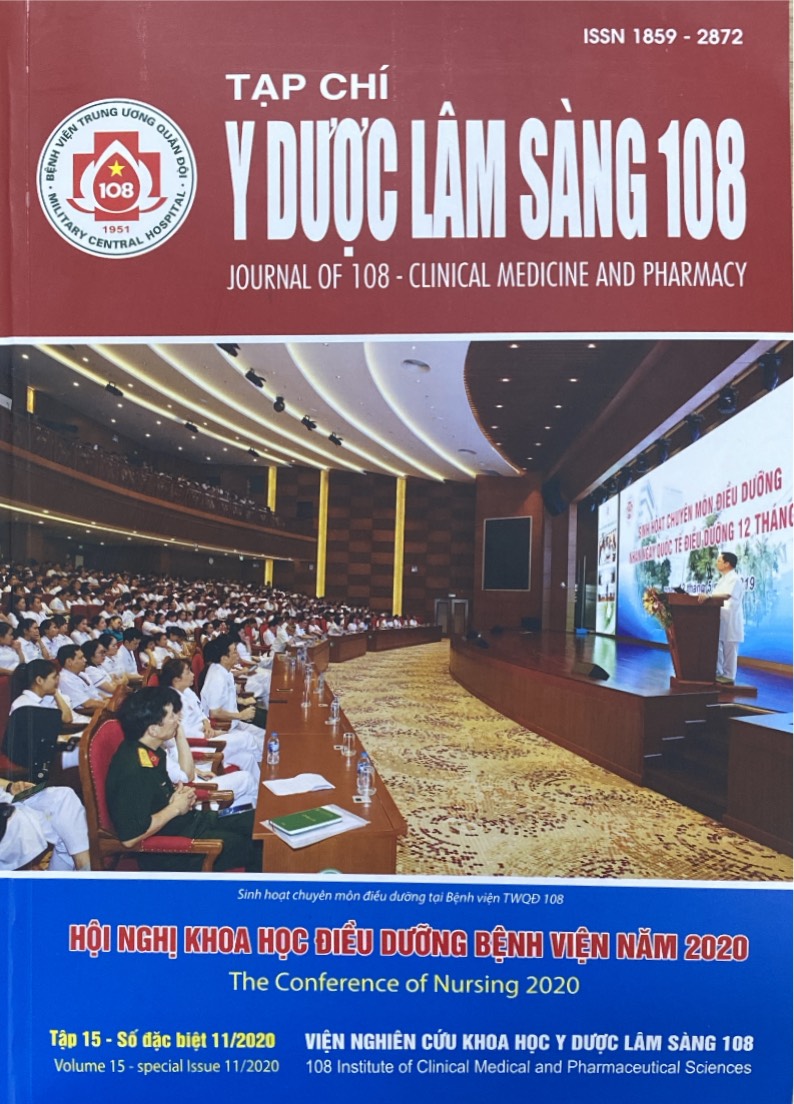Evaluation of patient care results after pancreaticoduodenectomy
Main Article Content
Keywords
Abstract
Objective: To assess the patient care results after pancreaticoduodenectomy. Subject and method: A cross-sectional study on all patients treated with pancreaticoduodenectomy at the Hepato Biliary and Pancreatic Surgery Department of 108 Military Central Hospital, from December 2018 to July 2019. Data were collected using a unified case report form. Result: A total of 32 patients, over 60 years old accounted for 62.5% and 56.2% were male in 32 patients treated. The BMI decreased by 2.38kg/m2 after surgery. The nurses applied multiple methods for pain relief. Only 7.7% of patients reported pain after 24 hours. The incision infection rate accounted for 25%. On the third day, over 65% of patients ate the porridge; on the fifth day, there were 96.9% of patients eating porridge and rice. Patients walked around the room and in the corridor of the hospital on the third day. Assured treatment results was 78.1% of patients. The most common complication was pancreatic fistula, occurs in 34.4% of patients. The mean hospital stay was 30 days. 100% recovered and discharged. Conclusion: The results showed that: good, fair, average and bad are 25%, 53.1%, 15.6% and 6.2%, respectively. Care of patients after pancreatectomy is very important, contributing to the prevention of complications after surgery, helping patients recover quickly.
Article Details
References
2. Nguyễn Minh Hiền ( ) Tổng quan chẩn đoán và điều trị đau. Truy cập ngày 20/4/2018 tại trang web http://hoithankinhhocvietnam.com.vn/tong-quan-chan-doan-va-dieu-tri-dau/
3. Hồ Văn Linh (2016) Đánh giá kết quả phẫu thuật cắt đầu tụy - tá tràng trong điều trị ung thư bóng vater. Luận án tiến sĩ Y học. Trường Đại học Y dược Huế.
4. Nguyễn Tấn Cường, Võ Tấn Long, Nguyễn Minh Hải và cộng sự (2004) Ung thư nhú Vater: Kết quả điều trị phẫu thuật tại Bệnh viện Chợ Rẫy. Y học Thành phố Hồ Chí Minh, 8(3), tr. 125-133.
5. Phạm Thế Anh (2013) Nghiên cứu ứng dụng phương pháp lập lại lưu thông tiêu hóa tụy dạ dày trong cắt khối tá tràng đầu tụy. Luận án Tiến sĩ Y học. Học Viện Quân y.
6. Triệu Triều Dương, Hồ Văn Linh, Nguyễn Cường Thịnh, Nguyễn Anh Tuấn, Lê Văn Thành (2015) Kết quả phẫu thuật cắt khối tá tụy trong điều trị các tổn thương đầu tụy, tá tràng tại Bệnh viện TWQĐ 108. Tạp chí Y Dược lâm sàng 108, tập 10, tr. 176-180.
7. Christopher LW (2012) Cancers of the periampullary region and the pancreas, Twelfth Edition, ed, Maingot's abdominal operations. The McGraw-Hill Companies.
8. Fang WL, Shyr YM, Su CH et al (2007) Comparison between pancreaticojejunostomy and pancreaticogastrostomy after pancreaticoduodenectomy. J Formos Med Assoc 106(9): 717-727.
9. Hiromichi Kawaida, Hiroshi Kono (2019) Surgical techniques and postoperative management to prevent postoperative pancreatic fistula after pancreatic surgery. World J Gastroenterol 25(28): 3722-3737.
10. Ashok Thorat and Wei - Chen Lee (2013) Critical care issues after major hepatic surgery. INTECH.
 ISSN: 1859 - 2872
ISSN: 1859 - 2872
